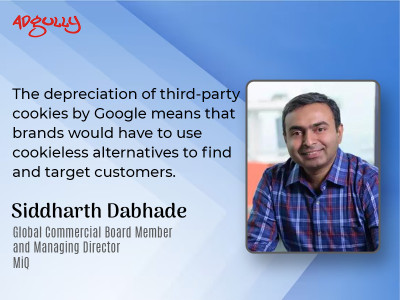Beyond cookies - Part 1: The rise of alternative solutions
Just the other day, Dan Taylor, Google Vice President of Global Advertising, affirmed the commitment to adhere to the 2024 timeline for cookie depreciation. As the sun sets on the era of third-party cookies, the landscape of programmatic advertising is undergoing a profound transformation. And in the wake of seismic shifts in digital advertising wrought by the demise of third-party cookies, programmatic advertising platforms find themselves at a pivotal crossroads. As the industry grapples with the challenge of maintaining effective ad delivery, a new era of privacy-conscious advertising dawns.
Dan Taylor has emphasised the unavoidable shift towards a more private internet that continues to support advertising use cases.
In the changing landscape, what is required is a transformative journey toward more privacy-centric advertising solutions. Notably, many underscore the urgency of abandoning legacy tools in favour of innovative approaches as the industry navigates the evolving landscape of online privacy in search of alternative solutions to third-party cookies. In this two-part series, Adgully attempts to find answers to the pressing question: How can the industry not only adapt, but also thrive in a digital realm where privacy and advertising harmoniously coexist, shaping the future of programmatic advertising beyond the era of third-party cookies?
Changing strategies
The shift away from third-party cookies has led advertising platforms to reconsider their targeting strategies in order to deliver ads while respecting user privacy, says Laura Quigley, SVP, APAC, Integral Ad Science. These platforms, according to her, are now embracing a privacy approach, which involves using targeting leveraging first-party data, implementing cohort-based targeting and utilising privacy-preserving identity solutions.
“Moreover, they are increasing transparency by providing advertisers with information about how data is used and giving users more control over their privacy settings. By collaborating with industry partners, investing in technologies that enhance privacy and conducting audits and reviews, these platforms demonstrate their commitment to data practices and privacy compliance. As programmatic advertising platforms adapt to the changing landscape after cookies, they are finding a balance between delivering ads and protecting user privacy in order to sustain the growth of this ecosystem,” says Laura Quigley.
The depreciation of third-party cookies by Google means that brands would have to use cookieless alternatives to find and target customers, observes Siddharth Dabhade, Global Commercial Board Member and Managing Director, MiQ. “The ad-tech industry has been preparing for this eventuality for years now, as Apple, Safari, and Firefox have already disabled cookies. We’ve seen a lot of organisations bolster their first-party data strategy to get authenticated user data by getting their consent, which includes data obtained through user interactions with their websites, apps, or other owned digital properties. This enables brands to personalise their marketing campaigns for their existing users and customers by gathering first-party data. Leveraging first-party data enables more accurate targeting and personalisation,” he says.
According to Dabhade, the other way to target without cookies is by using contextual targeting, which is to place an ad based on context using features like postcode, site domain, keywords, browser, OS, etc. There is also geo/ location-based targeting, which is the method of delivering ads to customers based on their geo-location and can help advertisers reach customers with a message tailored to their location.
Programmatic advertising platforms are shifting towards privacy-centric targeting strategies such as contextual targeting, where ads are placed based on content relevance rather than individual user data, says Sharath Madhavan, Lead - Performance Marketing, TheSmallBigIdea. Additionally, he adds, there’s an increased emphasis on first-party data utilisation, leveraging the advertiser’s own data for more personalised targeting, all while respecting user privacy preferences.
Beyond cookies
What technologies and approaches are emerging as alternatives to the familiar cookie-centric paradigm? From the integration of first-party data to the advent of privacy-preserving identity solutions and cohort-based targeting, the industry is witnessing a dynamic shift toward more privacy-conscious practices.
With the impending deprecation of third-party cookies, the programmatic advertising landscape is undergoing a significant transformation, points out Laura Quigley. She states that several technologies and approaches are emerging as viable alternatives, each offering unique advantages and influencing the efficiency and accuracy of programmatic advertising.
“Contextual targeting, which analyses the content of webpages or apps to infer user interests, has gained prominence as a privacy-compliant solution. This approach, however, can be limited in granularity and may only sometimes provide highly relevant ad placements. First-party data, collected directly from a brand’s website or app, offers a more precise understanding of user behaviour and preferences. Leveraging first-party data enables advertisers to create tailored audience segments and deliver personalised ad experiences,” Quigley explains.
She then talks about cohort-based targeting, which groups users with similar interests or behaviours into segments, and provides a balance between targeting effectiveness and user privacy. This approach, according to her, allows for targeted ad delivery without relying on individual user profiles.
“Emerging privacy-preserving identity solutions, such as anonymous identifiers and probabilistic matching, aim to provide user identification without compromising privacy. These solutions can enhance programmatic targeting accuracy while maintaining user anonymity. The adoption of these alternatives is impacting programmatic advertising in several ways. Contextual targeting is driving contextual relevance and improving brand safety. First-party data enhances audience segmentation and personalisation, leading to more effective ad campaigns. Cohort-based targeting provides a balance between reach and privacy while privacy-preserving identity solutions are addressing the need for user privacy in targeted advertising,” Quigley says.
According to her, as these technologies and approaches evolve, programmatic advertising adapts to a privacy-conscious landscape. The efficiency and accuracy of programmatic advertising will be shaped by the ability to balance effective targeting with user privacy, ensuring a sustainable and robust ecosystem for digital advertising, she adds.
In the absence of cookies, the ad-tech industry is seeking new ways of integrating data signals that follow privacy guidelines, says Siddharth Dabhade. Programmatic advertising in a privacy-first world needs to embed a robust first-party data strategy for efficiency and accuracy. According to him, as an alternative to cookie-based targeting, the following solutions are gaining popularity.
- Geo-contextual targeting: Contextual information is about the internet sites users visit, along with their browsing patterns and content preferences.
- Cohort-based targeting: Federated Learning of Cohorts (FLoC): Developed by Google as part of the Privacy Sandbox initiative, FLoC is designed to provide interest-based advertising without exposing individual user data. For example, Topics API, which enables interest-based advertising (IBA) without having to resort to tracking the sites a user visits.
- Identity resolution: Identity graphs and device graph mapping.
- Using AI and machine learning to analyse user behaviour patterns and make accurate predictions about user preferences without relying on individual user-level data.
- Unified IDs such as those developed by the Trade Desk.
“Emerging technologies like Unified ID 2.0 and Privacy Sandbox, along with contextual targeting, are gaining prominence as alternatives to third-party cookies. These solutions prioritize user privacy by aggregating and anonymizing data, aiming to maintain the efficiency and accuracy of programmatic advertising while reducing reliance on individual user tracking,” says Sharath Madhavan.
(In Part 2, we will delve into the way advertisers and agencies adjust their measurement and attribution models, and how industry collaborates to establish standards and guidelines.)





















Share
Facebook
YouTube
Tweet
Twitter
LinkedIn